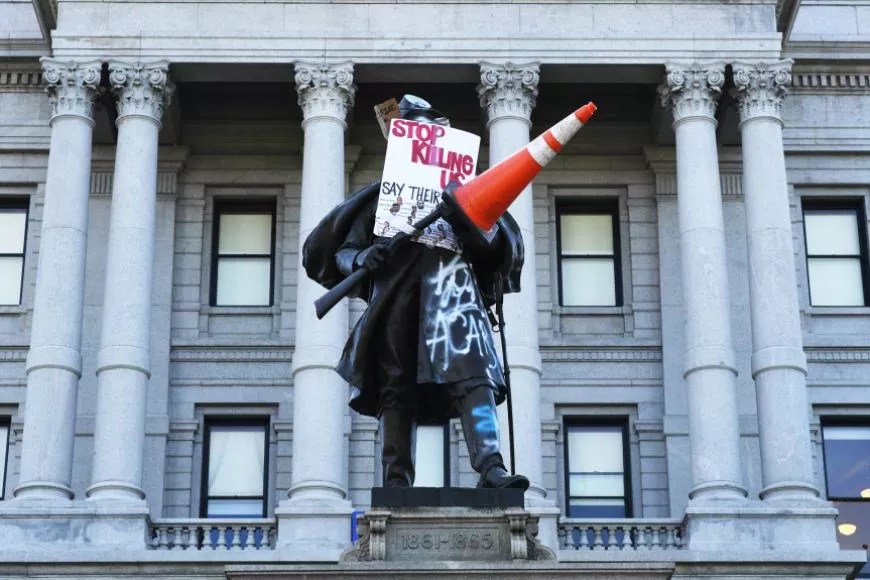
History Colorado

Audio By Carbonatix
On Monday, a decade after descendants of Sand Creek Massacre survivors were promised a memorial at the Colorado State Capitol, the Senate unanimously approved a resolution to place such a memorial at the Capitol; the House approved the resolution on Friday. And at least one thing had improved in the endless intervening years: Colorado lawmakers now agreed to put the memorial in a space of prominence, on the west side of the Capitol facing the mountains and the land taken from the tribes, in a spot where the statue of a Civil War soldier stood until it was toppled during the George Floyd protests in 2020.
A statue that once called the horrific events of November 29, 1864, a Civil War “battle.” They were anything but.
On that day, 675 volunteer soldiers led by Colonel John Chivington executed a dawn raid on a chief’s camp on the banks of Sand Creek, the big Sandy, where the occupants believed they were under the protection of the Army and even flew a white flag. But Chivington and his volunteers laid waste to the camp, which was largely occupied by women, children and elderly men, slaughtering at least 230 members of the Cheyenne and Arapaho tribes, including fourteen chiefs. They mutilated the bodies, taking human prizes and plunder promised by Territorial Governor John Evans.
Survivors ran through the creekbed, out on the plains, right out of the territory of Colorado. Today, their descendants live on reservations in Oklahoma, Wyoming and Montana. Several were at the Capitol yesterday.
While the troops paraded through Denver, word of the slaughter spread. Captain Silas Soule, who’d refused to let his troops participate, sent a letter to Major Edward Wynkoop, a participant in treaty discussions in the fall of 1864, describing the atrocities in horrifying detail. Soule later gave testimony to military investigators, even as Congress launched its own probes. Sand Creek became the most studied incident of the entire Civil War, and the feds declared it a massacre. Evans resigned his post; since Chivington had already resigned, he faced no charges…and even got a town named after him in southeastern Colorado, near the massacre site.
Soule was assassinated in April 1865 for daring to tell the truth. There’s a plaque at 15th and Arapahoe streets honoring his actions.
But despite all of the investigations, when a Civil War monument was erected in 1909 at the Colorado State Capitol, Sand Creek was listed as a “battle,” not the massacre it was. Decades would pass before a new plaque was installed to give context to what really happened at Sand Creek, an explanation that was carefully negotiated between lawmakers, historians and tribal representatives. And even when the soldier’s figure was toppled on June 25, 2020, that plaque remained by the empty platform that still stands outside the Capitol.

Gerald Anthony Shippen’s design for the Sand Creek Massacre memorial.
Sand Creek Massacre Foundation
By then, Congress had authorized the Sand Creek Massacre National Historic Site outside of Eads. Descendents of the Cheyenne and Arapahoe had started their annual Sand Creek Massacre Healing Run, honoring their ancestors along the 170-mile path from the massacre site to the Capitol steps. History Colorado Center had opened, then closed, Collision, its first exhibit devoted to Sand Creek that looked like Walt Disney had been consulted more than the descendants, as required by Congress. And then Governor John Hickenlooper stood on the west steps of the Capitol on the 150th anniversary of the Sand Creek Massacre and apologized to the tribes on behalf of Colorado.
Plans for a memorial were put in motion then, with the goal of placing it near the Civil War monument – but some lawmakers wanted it pushed to as obscure a spot as possible. There were enough quibbles over the initial design that the original artist withdrew in 2022. And, once again, there were concerns that the descendants were not being heard.
Finally, in November 2022, History Colorado Center opened a new exhibit: The Sand Creek Massacre: The Betrayal That Changed Cheyenne and Arapaho People Forever. It’s told in the words of the descendants, agreed to after careful consultations. Similar collaborations led to a new design for the Sand Creek memorial, whose initial funding was provided by the One Earth Future Foundation. Now that the resolution has passed, the Sand Creek Massacre Foundation will launch a campaign to finish fundraising so that the memorial can be placed in front of the Capitol next year, Colorado’s 150th anniversary of statehood.
The installation by Gerald Anthony Shippen will have Cheyenne chief Black Kettle and Arapaho chief Left Hand Arapaho flanking a mother with her child.
And above it all, an American flag.